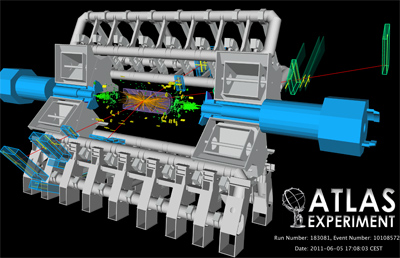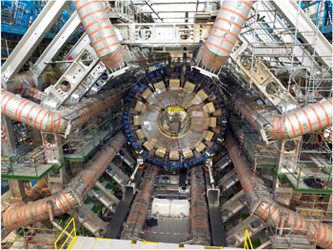|
|
||
|---|---|---|
 |
 |
|
| ATLAS | ||
ATLAS is one of two general-purpose particle detectors performing experiments at the Large Hadron Collider (LHC). The LHC is a 16.8 mile (27 km) diameter accelerator ring located 328 feet (~100 m) underground at CERN, the European Organization for Nuclear Research, in Geneva, Switzerland. By colliding particle beams into each other within the detector, physicists can observe the intrinsic behavior of subatomic particles to help understand more about the Standard Model and to unlock valuable information about the origin and nature of our universe. The Santa Cruz Institute for Particle Physics is one of several organizations involved in the development, construction and exploitation of the ATLAS detector. The Santa Cruz Institute for Particle Physics (SCIPP)at the University of California Santa Cruz was a member of the initial group of US institutions that petitioned the DoE and NSF to support US participation in LHC experiments due to the great potential for exciting research. We joined the ATLAS experiment in 1994. Our work has focused on the inner tracker and, by joining at an early stage in its development, we were able to contribute to its specification, design and construction. Our physicists, staff and students work on development of radiation hard silicon sensors and the radiation hard readout electronics, two areas that we have specialized in for the past 20 years. We conducted much of the R&D required to develop novel silicon sensors required for ATLAS and were in charge of the system electronics engineering of the 6 million channel silicon micro-strip tracker. During the construction phase, we were responsible for testing the custom designed readout integrated circuits (ICs) and assembling and then testing the multi-IC hybrid circuits that became part of each detector module (4088 in total for the detector). The group's principal physics interest is in searches for physics beyond the standard model, especially from theories with supersymmetry, and searches for the Higgs boson. Group members also work on improving measurements of jet energies, evaluating inner detector tracking performance, and developing new algorithms for identifying bottom quarks. Our ATLAS group currently consists of nine senior physicists (faculty and researchers) - Anthony Affolder, Marco Battaglia, Alex Grillo, Mike Hance, Alan Litke, Jason Nielsen, Hartmut Sadrozinski, Bruce Schumm, Abraham Seiden - postdoctoral researchers and graduate students, plus technical staff of an engineering physicist, engineers and technicians. At SCIPP, we also involve undergraduate students in our ATLAS detector development and data analysis work, typically 10 at any given time. |
||
| Research Home |
||
